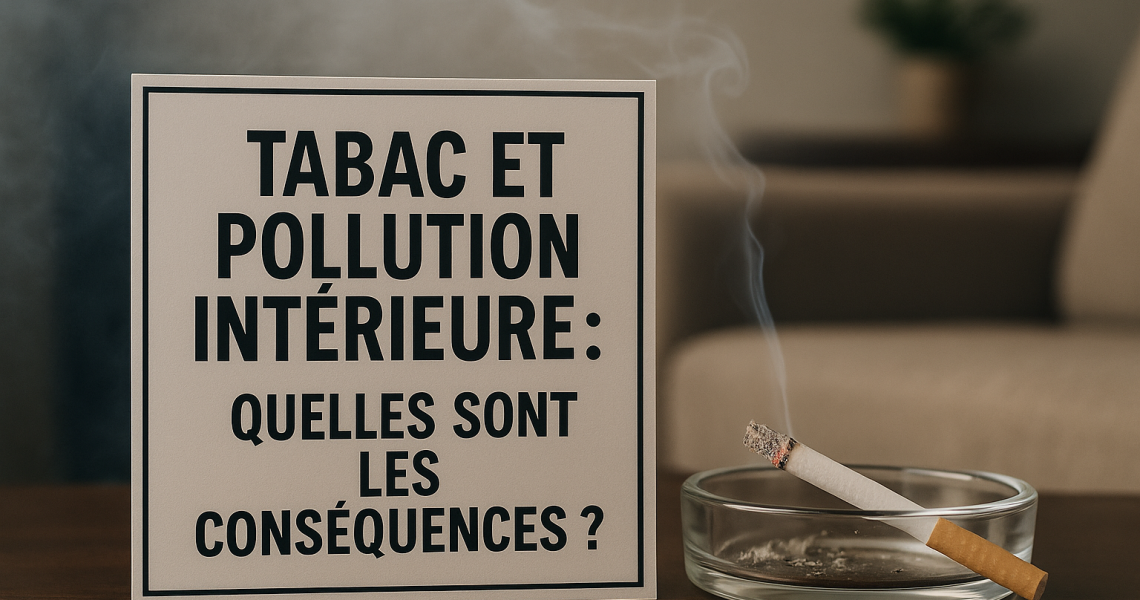Tobacco is one of the main sources of indoor pollution, entailing major health risks for the inhabitants of a home or enclosed space. In France, where smoking remains a public health problem, prolongedexposure to substances emitted by cigarettes contributes to a significant deterioration in indoor air quality.
The toxic compounds contained in smoke, such as formaldehyde, VOCs (volatile organic compounds)and other dangerous gases, gradually accumulate, increasing pollutant concentrations and the risk of respiratory illness. This page explores the effects of tobacco on theindoor environment and proposes solutions to reduce theimpact of these toxic substances.

How does tobacco pollute indoor air?
Prolongedexposure to cigarette smoke has a profound effect on air quality in the home. Contrary to what you might think, this pollution doesn’t disappear once you stop smoking. It seeps into walls, furniture and even ventilation systems, creating a long-term toxic environment.
Toxic substances in cigarette smoke
Tobacco smoke contains over 7,000 chemical substances, of which more than 250 are toxic and at least 70 are known carcinogens. Among the main pollutants are :
- Formaldehyde, an irritating chemical compound that increases the risk of cancer and respiratory ailments.
- VOCs (volatile organic compounds), such as benzene and acetaldehyde, contribute to indoor pollution and promote chronic illness.
- Fine particles penetrate deep into the lungs, causing respiratory and cardiovascular disease.
These toxic substances remain suspended inindoor air, absorbing into textiles and accumulating in the highest concentrations in poorly ventilated enclosed spaces.
The risks of exposure to second-hand and third-hand smoke
Exposure to passive smoking is particularly dangerous for children, the elderly and those suffering from respiratory problems such asasthma. Even if we avoid smoking directly next to these vulnerable populations, toxic particles remain present in theindoor environment for a long time.
There are two types of indirectexposure:
- Passive smoking, which involves people involuntarily inhaling the environmental smoke produced by cigarettes.
- Tertiary smoking, which refers to the toxic residues left on furniture, carpets, curtains and even smokers’ skin. These toxic substances can be reactivated by contact withwater andhumidity, further aggravating indoor air pollution.
Numerous studies show that these forms ofexposure considerably increase the risk of cancer, respiratory disease and cardiovascular disorders.
You may also be interested in this article: Become a Mylasertabac franchisee in the field of smoking cessation and other addictions.
Impact of tobacco on air quality and the indoor environment
The toxic compounds contained in tobacco smoke have a lasting impact on air quality and theindoor environment. In addition to the health risks, we note :
- An accumulation of yellowish deposits on walls and ceilings, requiring frequent renovation work.
- Damage to furniture, curtains and textiles, which retain odors and pollutant particles.
- Interaction with other household pollutants, such as mold,asbestos and household chemicals, further exacerbates the toxicity of indoor air.
How to limit indoor pollution caused by smoking?
Even if the best solution is tostop smoking, certain measures can help reduce theimpact of cigarette smoke on theindoor environment and improve air quality.
Efficient ventilation and air purification
Daily ventilation is essential to reduce the concentration of pollutants inindoor air. We recommend :
- Open windows at least 30 minutes a day, even in winter, to renew the air and expel toxic gases.
- Install air purifiers equipped with HEPA filters, capable of capturing the fine particles and toxic substances present in tobacco smoke.
- Use depolluting plants, such as ivy or Areca palm, which absorb part of the VOCs and improve air quality.
Clean impacted surfaces and textiles
Regular maintenance is essential to remove impregnated cigarette residues from surfaces and fabrics. Effective solutions include :
- Wash curtains, cushions and carpets with natural products such as white vinegar or baking soda.
- Clean walls and furniture with a mixture ofwater, black soap and products suitable for delicate surfaces.
- Disinfect ventilation systems, as they trap toxic particles and can redistribute indoor pollution throughout the house.

Quit smoking for healthier air
The best way to preserve your indoor environment is tostop smoking. As soon as you stop smoking, concentrations of pollutants in the air gradually decrease, and occupants’ quality of life rapidly improves.
The anti-smoking laser is an effective, natural method for giving up cigarettes without frustration. By stimulatingacupuncture points, it helps to immediately reduce the desire to smoke and limit withdrawal symptoms. Many smokers have successfully quit for good thanks to this technology, contributing to a healthier environment for themselves and their loved ones.
Conclusion
Tobacco is one of the main causes of indoor pollution, affecting not only air quality but also the health of occupants.Exposure to the toxic compounds in cigarette smoke increases the risk of respiratory disease,asthma and cancer.
Although certain solutions can help limit these effects, the only way toeliminate this pollutionpermanently isto stop smoking. Thanks to the anti-smoking laserit’s now possible to put an end to this addiction easily and stress-free, offering a healthier indoor environment for the whole family. 🚭✨
